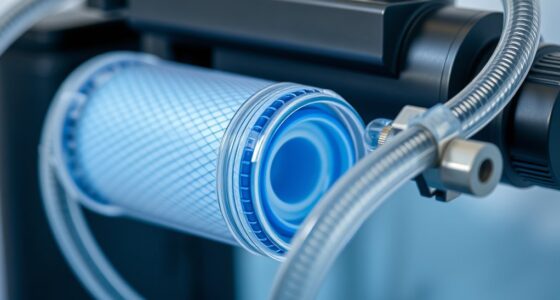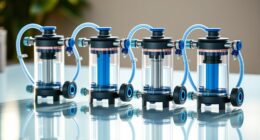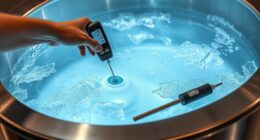To accurately test your water quality at home, you need to measure key factors like hardness, pH, TDS, and contaminant levels. Calculations help you interpret test results against safety standards, showing if your water has safe mineral content, proper acidity, or harmful bacteria. Knowing how to perform these calculations guarantees you identify issues early. Keep exploring deeper, and you’ll discover the essential steps to keep your water safe and clean every day.
Key Takeaways
- Accurately calculate TDS levels to assess overall mineral content and determine filtration needs.
- Convert test kit results into ppm or mg/L for precise contaminant measurement.
- Compare measured contaminant levels with safety thresholds like EPA or WHO standards.
- Calculate mineral content and pH consistency to identify water chemistry issues impacting safety.
- Regularly review microbial and chemical test results to ensure ongoing water safety and compliance.
Calculating Water Hardness and Mineral Content
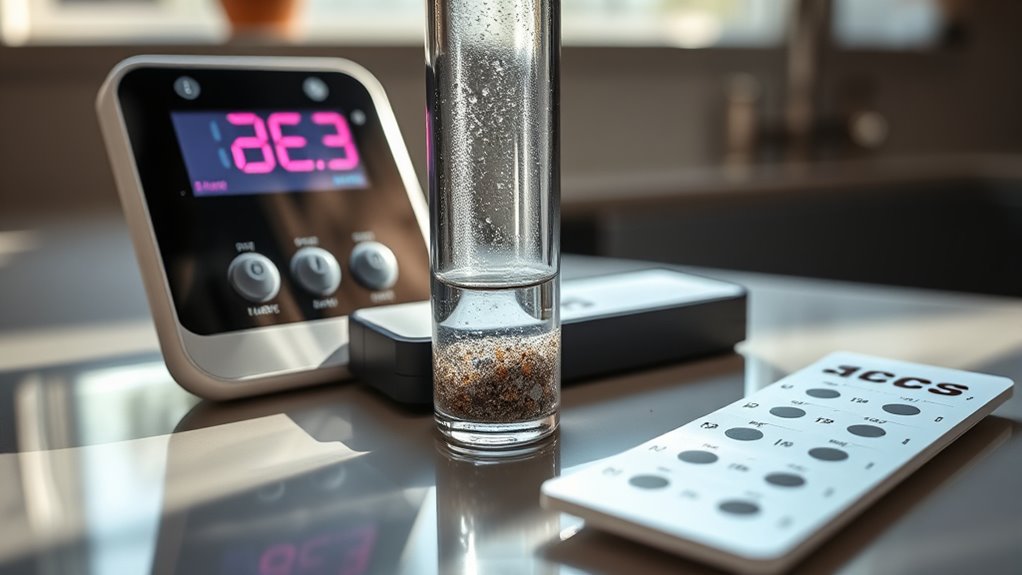
Understanding how to calculate water hardness and mineral content is essential for evaluating your water quality at home. When you perform water filtration tests, you can identify levels of calcium and magnesium, which are primary contributors to hardness. These minerals engage in chemical reactions with soap, causing soap scum, and can affect appliance efficiency. To determine mineral content, you might use test kits that measure total dissolved solids (TDS), giving you a clear picture of mineral presence. Knowing these levels helps you decide if additional filtration or water softening is necessary. Accurate calculations allow you to better understand how minerals impact your water and ensure your filtration system effectively reduces unwanted elements, leading to safer, better-tasting water. Understanding water chemistry is crucial for maintaining optimal water quality in your home.
Interpreting Ph Levels and Acid-Base Balance
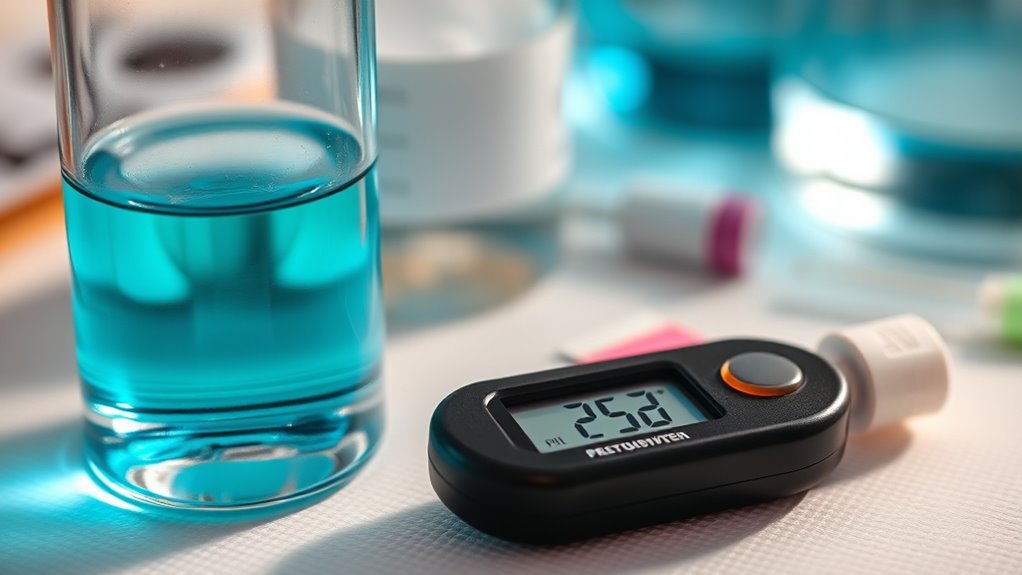
Interpreting pH levels and acid-base balance is crucial for evaluating your water quality because these factors directly influence water safety and taste. pH fluctuation indicates how acidic or alkaline your water is, impacting corrosion and potential health risks. Regular testing helps you spot sudden changes that could signal contamination. Understanding acid-base buffering is key; it’s your water’s ability to resist pH shifts when acids or bases are introduced. Strong buffering maintains stability, while weak buffering allows pH to fluctuate more easily. Monitoring techniques are essential for accurate assessment of these parameters in your water. Consistent pH levels between 6.5 and 8.5 generally signify healthy water. If pH drifts outside this range, it can suggest underlying issues that need addressing. Monitoring these parameters ensures your water remains safe, palatable, and balanced for everyday use.
Estimating Contaminant Concentrations
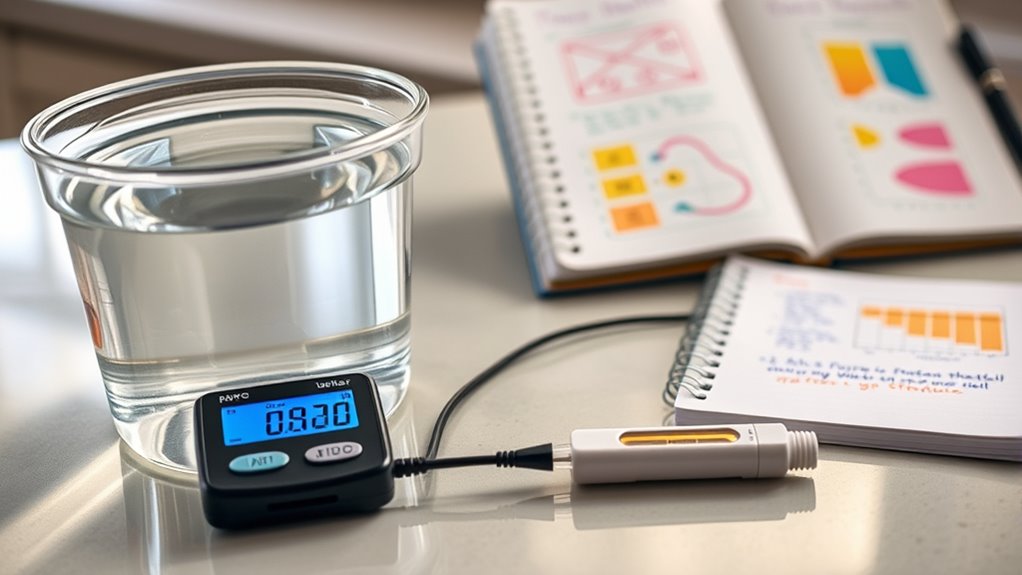
To accurately estimate contaminant concentrations, you need to consider the sample volume you collect. Smaller samples may require adjustments to guarantee precise calculations, while larger samples can improve accuracy. Knowing how to calculate contaminant levels based on your sample is essential for reliable water testing at home. Additionally, understanding the role of guidance and support in fostering confidence can help in properly interpreting your results.
Sample Volume Considerations
Choosing the right sample volume is essential for accurately estimating contaminant concentrations in your water. A larger sample can provide more precise results, but it also requires careful management of flow rate to guarantee consistency. If the flow rate is too high, contaminants may be unevenly distributed, leading to inaccurate readings. Conversely, a very small sample might not represent the overall water quality, especially for low-level contaminants. Proper sample preservation is also critical; use clean, airtight containers and keep samples cool to prevent changes before testing. Balancing these factors ensures your sample accurately reflects the water’s true contamination level. Additionally, understanding headphone types can help ensure your testing setup includes the right audio alerts or instructions if using electronic testing devices. Always follow testing kit instructions regarding sample volume to improve reliability and consistency in your results.
Calculating Contaminant Levels
Calculating contaminant levels involves converting test results into meaningful concentrations that reflect your water’s safety. First, review your test data carefully, noting any pH readings. If your pH needs adjustment, consider pH adjustment techniques to get accurate measurements. To estimate contaminant concentrations, use the test kit’s instructions to convert color changes or readings into parts per million (ppm) or milligrams per liter (mg/L). If your water has mineral content, mineral filtration can help remove or reduce certain contaminants, but it also influences the readings. Additionally, understanding the contrast ratio of your testing setup can improve the accuracy of colorimetric assessments. Always account for any filtration effects when calculating levels. By accurately interpreting these results, you can better determine whether your water requires further treatment or is safe for consumption.
Determining Safe Drinking Water Standards
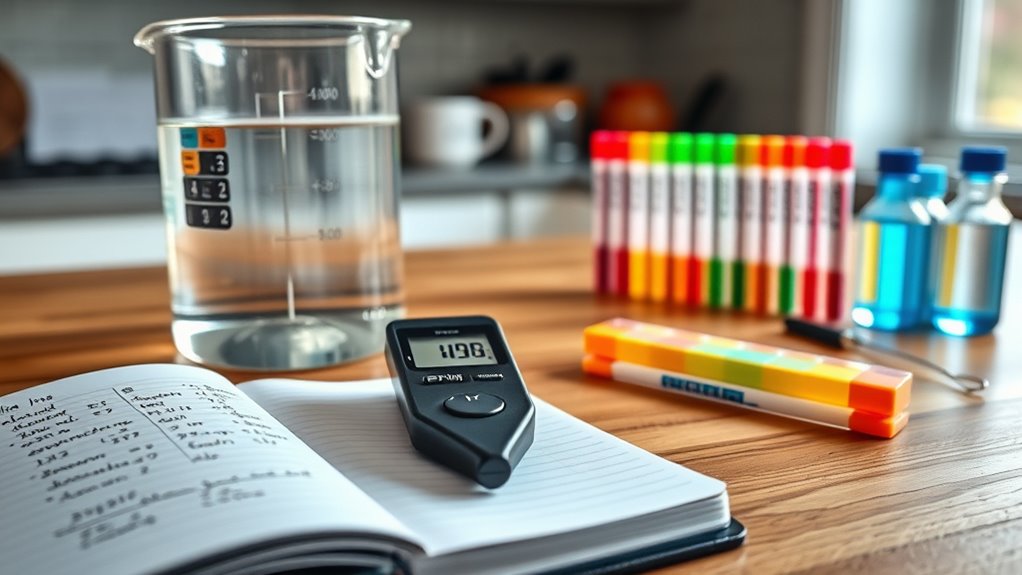
How do you know if your water is safe to drink? First, you need to compare your test results to established safe drinking water standards. These standards ensure water is suitable for consumption and free from harmful contaminants. Pay close attention to pH levels; if your water’s pH is too low or high, you might need pH adjustment to make it safer. Additionally, chlorine removal is essential if your water contains excessive chlorine, which can cause taste and odor issues. Removing chlorine not only improves water’s flavor but also helps guarantee it meets safety standards. Regular testing and understanding these benchmarks allow you to determine if your water is safe or if further treatment is necessary. Staying within these guidelines guarantees healthier, cleaner drinking water for your household. Monitoring water quality parameters regularly helps maintain safe drinking water standards over time.
Assessing Total Dissolved Solids (TDS)
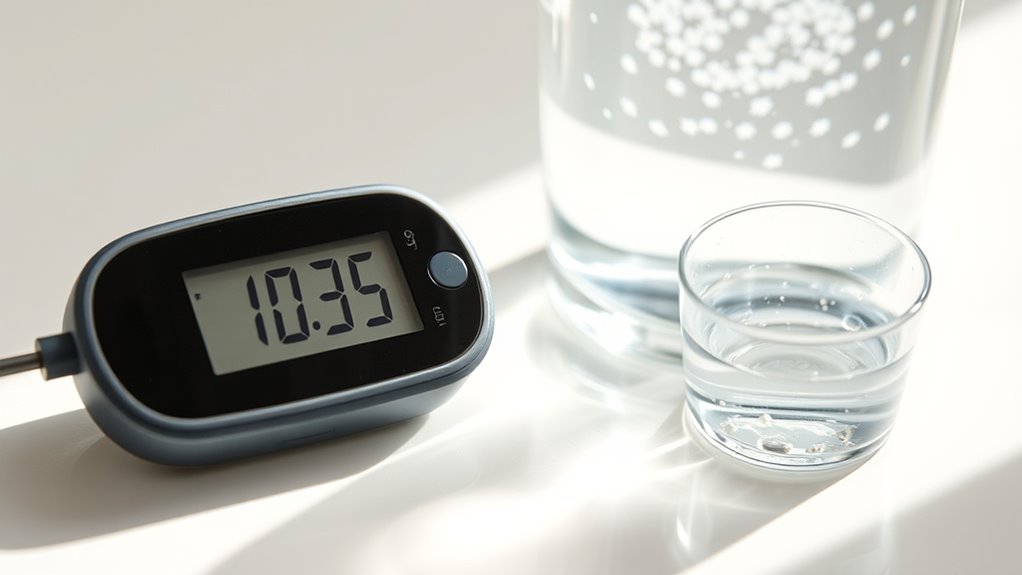
Evaluating Total Dissolved Solids (TDS) is essential for determining water quality because high levels can indicate contamination or poor water taste. TDS measures minerals, salts, and ions dissolved in water, which can affect water filtration effectiveness and trigger chemical reactions that alter water chemistry. To assess TDS, you can use a TDS meter, which provides a quick reading. Imagine this:
| TDS Level | Water Quality | Possible Issue |
|---|---|---|
| 0-50 ppm | Excellent | Very pure, minimal salts |
| 51-150 ppm | Good | Slight mineral presence |
| 151-500 ppm | Fair | May affect taste or filtration |
Monitoring TDS helps you decide if your water needs filtration or treatment. Adjusting water chemistry ensures safe drinking water and ideal filtration performance. Being aware of water quality parameters allows homeowners to maintain optimal water conditions and prevent potential problems.
Calculating Bacterial and Contaminant Thresholds
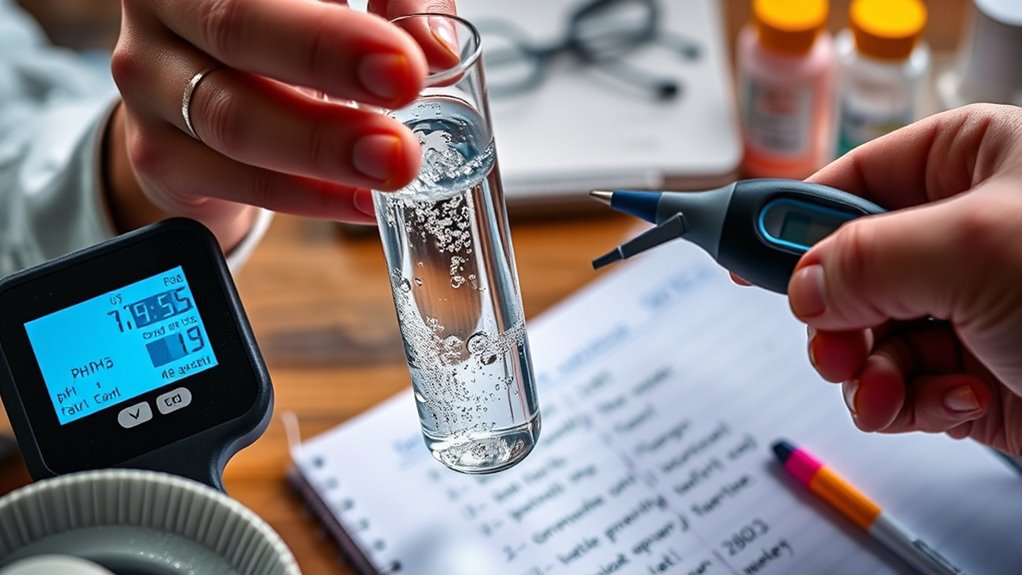
Understanding bacterial limits standards and contaminant safety levels helps you determine if your water is safe to drink. By knowing these thresholds, you can identify when contamination poses a health risk. Let’s explore how to calculate these critical values to protect your household.
Bacterial Limits Standards
To guarantee your water remains safe to drink, you need to know the bacterial limits set by health standards. These microbiological standards define the maximum allowable levels of bacteria in drinking water. Understanding these limits helps you assess water safety accurately. Bacterial limits are typically measured by the presence of coliform bacteria, including E. coli, which indicate contamination. Regular testing and awareness of conflict resolution skills can help address potential issues early, ensuring water safety is maintained.
Key points include:
- Maximum Contaminant Level (MCL): The highest permissible bacterial count.
- Regulatory Agencies: EPA and WHO set these microbiological standards.
- Testing Frequency: Regular testing ensures standards are met.
- Safe Thresholds: Zero detectable E. coli or coliform bacteria in a sample.
Adhering to these standards ensures your water is safe and compliant with health regulations.
Contaminant Safety Levels
Once you know the bacterial limits for safe drinking water, the next step is to determine the specific contaminant safety levels. These contaminant thresholds help you identify whether your water is safe through home water testing. To understand this better, consider the following table:
| Contaminant | Safe Threshold (ppm or CFU/mL) |
|---|---|
| Lead | 0.015 ppm |
| Nitrates | 10 ppm |
| E. coli | None detected |
| Chlorine (residual) | 4 ppm |
Knowing these safety levels allows you to interpret home water testing results accurately and take action if thresholds are exceeded. Monitoring contaminant thresholds ensures your water remains safe and healthy for daily use. Additionally, understanding water filtration technologies can help you choose appropriate methods to reduce contaminants effectively.
Frequently Asked Questions
How Often Should I Test My Water at Home?
You should test your water at home at least once a year using water testing kits to guarantee it meets water quality standards. If you notice changes in taste, smell, or color, test more frequently. For households with well water or potential contamination risks, testing every six months is recommended. Regular testing helps catch issues early, keeping your water safe and compliant with water quality standards.
What Equipment Is Best for Accurate Water Testing?
Oh, you’d think a simple test kit would do, but for real accuracy, invest in high-quality testing kits with certified calibration methods. Look for digital meters or lab-grade kits that offer precise readings. While some kits claim to be foolproof, true accuracy comes from properly calibrated equipment and following manufacturer instructions carefully. Don’t skimp—your health depends on reliable results, after all.
Can Home Tests Replace Professional Laboratory Analysis?
Home tests with DIY kits can give you a general idea of water quality, but they can’t replace professional laboratory analysis for accuracy. Lab accuracy is higher because labs use advanced equipment and methods, ensuring more reliable results. If you need precise data for health or safety reasons, it’s best to send samples to a certified lab rather than relying solely on DIY tests.
How Do Weather Changes Affect Water Quality Readings?
Weather patterns and seasonal fluctuations definitely impact your water quality readings. When temperatures rise or fall, or after heavy rain, your tests might show more contaminants or changes in pH levels. These fluctuations aren’t always due to actual water quality issues but weather variations. So, it’s best to test consistently and consider recent weather conditions to get accurate, reliable results. Always account for seasonal changes when interpreting your readings.
What Are Immediate Steps if Water Tests Show High Contamination?
If your water tests show high contamination, act immediately by identifying potential contamination sources like nearby industrial sites or septic leaks. Use emergency treatment methods such as boiling water for at least one minute or using chlorine tablets to disinfect. Avoid drinking or using contaminated water until tests confirm safety. Always contact local health authorities for guidance and further testing to make sure your water is safe again.
Conclusion
By mastering these calculations, you’re becoming a vigilant guardian of your water’s purity, like a skilled captain steering through a vast, invisible ocean. Each measurement acts as a compass, guiding you past hidden dangers toward safe, crystal-clear waters. With every test, you’re building a fortress of health around your home, ensuring your water flows pure and strong—an unbreakable shield against unseen threats, giving you peace of mind with every sip.


